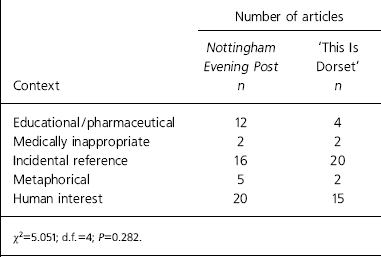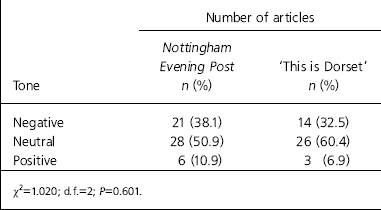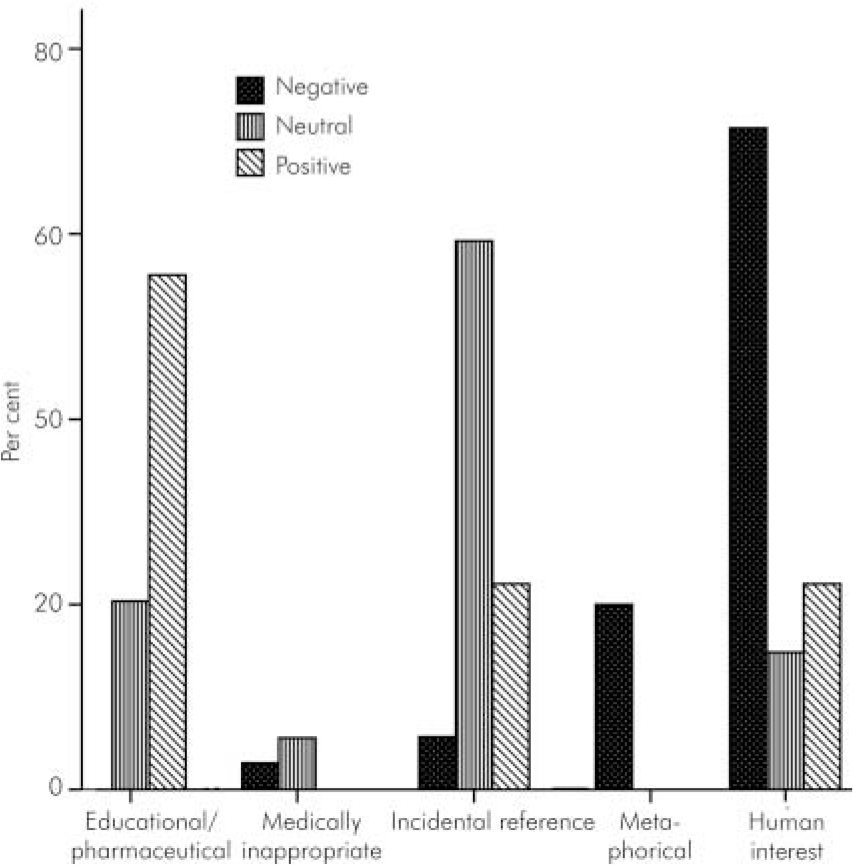The media is the foremost source of information about mental illness for the lay public (Reference BorinsteinBorinstein, 1992; Reference Philo, Secker and PlattPhilo et al, 1994). It has an important role to play in disseminating factual and accurate information about mental illness while reporting on events and persons that are newsworthy and interesting. The high-profile reporting of crimes in which a person with mental illness is the perpetrator and the paucity of stories about people successfully managing mental illness may have contributed to stigmatisation.
Nunnally's (Reference Nunnally1961) seminal work Popular Conceptions of Mental Health demonstrated how the American media presented a distorted picture of those with mental illness, describing them as having ‘negative halos’ and being regarded as all things bad. One of his main findings was:
‘The symptoms of mental illness are exaggerated, the causes and treatments oversimplified and often erroneous, and mental illness usually appears in a context of horror, sin and violence’ (p. ).
Since then there have been numerous studies from different parts of the world looking at the depictions of mental illness. A recent UK study by Lawrie (Reference Lawrie2000) looked at newspaper headlines related to psychiatry and found that 64% of the headlines were negative in tone. Previous UK studies by Barnes & Earnshaw (Reference Barnes and Earnshaw1993), Philo et al (Reference Philo, Secker and Platt1994) and Ward (Reference Ward1997) reported that around 60, 66 and 50% respectively of newspaper reports related to mental illness were negative. The negative reports are predominantly related to violence. Because of the tendency to vilify those with mental illness, they might be more likely to be depicted negatively in the local press of areas with high crime rates, and this might lead to increased stigmatisation.
This study tests the hypothesis that there will be a difference in the portrayal of schizophrenia in local newspapers from regions with differing levels of crime. Nottinghamshire is a county with a crime rate of 31.5 per 1000 inhabitants. Its largest city is Nottingham, with an all-crime rate of 61.5 per 1000 persons (March to July, 2005, Home Office statistics obtained from http://crimestatistics.org.uk). The daily local newspaper with the highest circulation (apart from free newspapers) is the Nottingham Evening Post (total circulation of 68 355, July to December 2005, Newspaper Society database at http://www.nsdatabase.co.uk). In comparison, Dorset has a low crime rate of 20.2 per 1000 population. Bournemouth, the largest town, has a crime rate of 32.9 per 1000 inhabitants (March to July, 2005, Home Office statistics). The local dailies with the highest circulation (apart from free newspapers) are the Daily Echo and the Dorset Echo (total circulations of 33 900 and 19 444 respectively). The UK national average crime rate is 25.5 per 1000 population.
Method
We searched for all articles containing the terms schizophrenia, or schizophrenic or schizo in the Nottingham Evening Post and ‘ This is Dorset’ (UK Newsquest Regional Press - This is Dorset; a database which combines all articles from the Daily Echo and Dorset Echo) using the Lexis-Nexis Professional UK newspaper database between 1 January 2003 and 25 May 2006. Lexis-Nexis does not support searches within individual Dorset newspapers.
All articles were classified according to the context in which the term appeared. The categories are similar to those used by Duckworth et al (Reference Duckworth, Halpern and Schutt2003) in a similar study of American national newspapers. Contextual categories included:
-
• educational/pharmaceutical articles focusing on causes, symptoms, treatments or medication
-
• incidental reference, where the disease or patient is not the main focus of the article but is mentioned (e.g.‘Peter's friend also suffers from schizophrenia’ or ‘the film touches on topics such as schizophrenia’)
-
• human Interest, where the illness or a person with schizophrenia is the main focus of the article
-
• metaphorical, where the term is used as a metaphor (e.g. the weather will be schizophrenic)
-
• medically inappropriate (e.g. schizophrenia is a form of depression).
Articles were also classified according to their tone. Day & Page (Reference Day and Page1986) in a study of Canadian newspapers used ‘tone’ to describe the general attitude of a newspaper article towards mental illness or psychiatric services. Since then many researchers in this field have included this as an outcome measure. We classified articles according to Wahl et al (Reference Wahl, Wood and Richards2002) as:
-
• positive, showing people with mental illness as possessing strengths, abilities, potential for recovery and for meaningful contribution to society
-
• negative, showing people with mental illness as weak, violent, incompetent, helpless, or unattractive.
Articles which were neither positive nor negative in tone were classified as neutral. Articles were also classified based on narrative into ‘ reported’ or ‘first-person’ where patients or carers were directly quoted.
Using the statistical package R (http://mirrors.sunsite.dk.cran) for sample size calculation, based on an expected effect size of 0.4, and arbitrarily setting significance levels at 0.05 and power at 0.8 respectively, it was calculated that 42 articles were needed for each group.
SPSS version 14 for Windows was used for statistical analysis. Chi-square tests were performed to look for differences in the context and tone in which schizophrenia was reported between the Dorset and Nottinghamshire newspapers.
Results
There were 98 articles identified: 55 from the Nottingham Evening Post and 43 from ‘This Is Dorset’. There was no significant difference in the context in which schizophrenia appeared in the Dorset and Nottinghamshire newspapers (Table 1). There was no significant difference in the tone of the newspapers (Table 2). Overall, 36.1% of articles were negative in tone, 56.7% were neutral and 7.2% were positive. There were 6 articles out of 98 where a person with schizophrenia or their carer was quoted directly. These articles were all positive or neutral in tone. The majority of articles of human interest were negative in tone (Fig. 1).
Table 1. Context in which schizophrenia is depicted in local newspapers

| Number of articles | |||
|---|---|---|---|
| Context | Nottingham Evening Post n | ‘ This is Dorset’ n | |
| Educational/pharmaceutical | 12 | 4 | |
| Medically inappropriate | 2 | 2 | |
| Incidental reference | 16 | 20 | |
| Metaphorical | 5 | 2 | |
| Human interest | 20 | 15 | |
χ2=5.051; d.f.=4; P=0.282
Table 2. Tone of articles appearing in local newspapers

| Number of articles | |||
|---|---|---|---|
| Tone | Nottingham Evening Post n (%) | ‘ This is Dorset’ n (%) | |
| Negative | 21 (38.1) | 14 (32.5) | |
| Neutral | 28 (50.9) | 26 (60.4) | |
| Positive | 6 (10.9) | 3 (6.9) | |
χ2=1.020; d.f.=2; P=0.601
Discussion
With the preoccupation of the UK media with associations between mental illness and dangerousness (Reference Barnes and EarnshawBarnes & Earnshaw, 1993; Reference Philo, Secker and PlattPhilo et al, 1994; Reference WardWard, 1997), and the tendency to vilify those with mental illness (Reference NunnallyNunnally, 1961), it seemed plausible that in an area such as Nottingham with a high crime rate, the depictions of mental illness in the local paper might be worse than in a local paper from an area such as Dorset with a lower crime rate. This research does not support such a relationship.

Fig. 1. Distribution of negative, neutral and positive newspaper articles on schizophrenia according to context
The absence of any increased prevalence of negative attitudes towards people with schizophrenia in areas of high crime suggests that efforts of the Royal College of Psychiatrists and agencies such as Mind, together with the media, have been successful in promoting better coverage of mental health.
The complete absence of the use of the derogatory term ‘schizo’ in the local newspapers studied is indicative of good journalism. However, the predominance of negative stories about schizophrenia and people with schizophrenia indicates that the most common way in which the general public encounter these individuals is usually in associations with violence. Out of the 35 negative articles, 28 (80%) were related to crime and violence. The newspapers’ responsibility to cover stories about violent crime is one social variable which might explain this. There is a scarcity of stories about people with schizophrenia managing their illness in the community, responding to treatments, or leading fulfilling lives. However, an example of such a story appeared in the Dorset Echo (23 July 2004) describing a man diagnosed with schizophrenia who hiked to Mount Everest's base camp to raise funds for the mental health charity Rethink. Interestingly, the six articles where a person with schizophrenia or their carer was given a voice were neutral or positive. This suggests that presenting first-person narratives from people with schizophrenia and their carers might reduce the imbalance in their portrayal.
The use of schizophrenia as a metaphor was interesting. Its use is not as extensive as in the American media, where 28% of the use is metaphorical (Reference Duckworth, Halpern and SchuttDuckworth et al, 2003). An example of metaphorical use is illustrated by this description of Bournemouth which appeared in ‘This is Dorset’: Although it is impossible to separate a word from its many meanings, it is important to understand what the word ‘schizophrenia’ might mean to the lay public because of its use as a metaphor for changeability and instability.
‘This popular seaside town is strangely schizophrenic: traditional guesthouse walks on the front and variety shows on the one hand, beery stag nights and full-on clubbing on the other’ (28 March 2003).
The overall percentage of articles that are negative is 36.1%. This is lower than figures reported in previous UK studies (Reference Barnes and EarnshawBarnes & Earnshaw, 1993; Reference Philo, Secker and PlattPhilo et al, 1994;Reference WardWard, 1997) and is in keeping with more recent Belgian (Reference Pieters, De Gucht and KajoschPieters et al, 2003) and American studies (Reference Corrigan, Watson and GraciaCorrigan et al, 2005), which report rates of 38% and 39% of negative articles respectively.
However, as the methodologies and the search terms used in all of these studies are different, this study of local newspapers can only suggest a possible improvement in the coverage of mental illness rather than report definite progress. Another limitation of this study is the possibility of a type 2 error in our rejection of the null hypothesis owing to a small sample size.
We are currently looking at the portrayal of schizophrenia in UK national newspapers and the use of schizophrenia as a metaphor in particular.
Finally, despite the figures published by the Conservative think tank, Reform, which show that Nottingham is the most dangerous place to live (Reference FordFord, 2006), the authors of this paper enjoy living and working here.
Declaration of interest
None.
Acknowledgements
We thank the editors of the newspapers reported in this article, Graham Glen (Nottingham Evening Post), Neal Butterworth (The Daily Echo) and David Murdock (Dorset Echo) for discussing this paper and its findings.






eLetters
No eLetters have been published for this article.